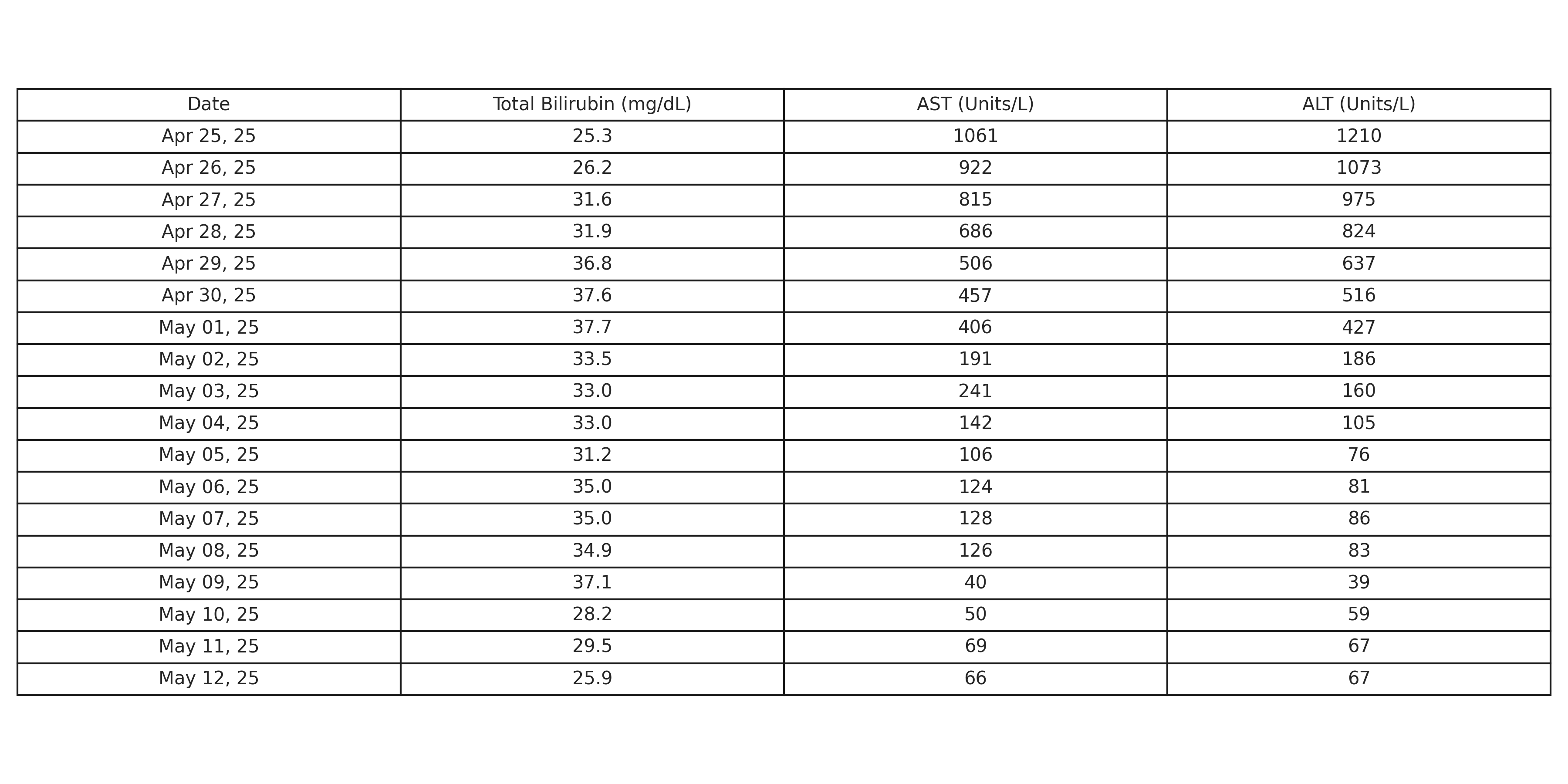Tuesday Poster Session
Category: Liver
P6022 - Acute Liver Injury in Waldenström Macroglobulinemia
Tuesday, October 28, 2025
10:30 AM - 4:00 PM PDT
Location: Exhibit Hall

Blake Flores Semyonov, DO
HCA Florida Largo Hospital
Nashville, TN
Presenting Author(s)
Blake Flores Semyonov, DO1, Vamsee Mupparaju, MD2, Rebecca Miller, DO3, Roxana Bodin, MD3
1HCA Florida Largo Hospital, Pinellas Park, FL; 2HCA Florida Citrus Hospital, Inverness, FL; 3HCA Florida Largo Hospital, Largo, FL
Introduction: Waldenström macroglobulinemia (WM) is an indolent B-cell lymphoproliferative disorder defined by IgM monoclonal gammopathy and bone marrow infiltration. While liver involvement is uncommon, WM can rarely manifest with hepatic infiltration or immune-mediated injury. In patients with underlying liver disease, even subtle hepatic involvement may trigger decompensation. We present a case of acute-on-chronic liver failure likely precipitated by treatment-naive WM in a patient with alcohol associated cirrhosis, highlighting the complexity of overlapping hepatic and hematologic disorders.
Case Description/
Methods: A man with alcohol associated cirrhosis abstinent for 20 years, WM with MYD88 mutation and IgM kappa restriction, chronic kidney disease, and prior nephrectomy for renal mass presented with fatigue, jaundice, and weakness. He was treatment-naive and asymptomatic until outpatient labs showed total bilirubin of 26 mg/dL and INR 3.8, prompting admission. MELD was 40 and CLIF-C 53. Total protein was 9.3 g/dL, M-spike 4.5 g/dL, lambda light chains 309.4 mg/dL, and kappa/lambda ratio 0.03.
Abdominal ultrasound showed patent hepatic vessels. Liver biopsy revealed moderate to severe portal and lobular inflammation with lymphocytes, plasma cells, histiocytes, neutrophils, and focal hepatocyte necrosis. Prussian blue stain was negative. Autoimmune markers, hepatitis panel, iron studies, ceruloplasmin, and EBV, CMV, HSV, HIV testing were negative. With renal failure requiring dialysis and ineligibility for transplant due to malignancy, palliative chemotherapy was initiated with rituximab, cyclophosphamide, and dexamethasone. Following initiation of chemotherapy, liver function tests improved.
Discussion: In this case, the absence of common risk factors such as immunosuppression or HIV infection obscured the diagnosis. The patient’s systemic findings including cytopenias, renal dysfunction, ascites, and radiographically atypical liver lesions mimicked malignancy or infiltrative disease, leading to extensive workup. This case highlights the importance of considering infectious etiologies, including Bartonella henselae, in patients with multisystem involvement and unexplained hepatic lesions, regardless of immune status. Early recognition is critical, as antimicrobial therapy can lead to complete resolution and prevent unnecessary invasive interventions.

Figure: Trends in liver function tests throughout hospital course
Disclosures:
Blake Flores Semyonov indicated no relevant financial relationships.
Vamsee Mupparaju indicated no relevant financial relationships.
Rebecca Miller indicated no relevant financial relationships.
Roxana Bodin indicated no relevant financial relationships.
Blake Flores Semyonov, DO1, Vamsee Mupparaju, MD2, Rebecca Miller, DO3, Roxana Bodin, MD3. P6022 - Acute Liver Injury in Waldenström Macroglobulinemia, ACG 2025 Annual Scientific Meeting Abstracts. Phoenix, AZ: American College of Gastroenterology.
1HCA Florida Largo Hospital, Pinellas Park, FL; 2HCA Florida Citrus Hospital, Inverness, FL; 3HCA Florida Largo Hospital, Largo, FL
Introduction: Waldenström macroglobulinemia (WM) is an indolent B-cell lymphoproliferative disorder defined by IgM monoclonal gammopathy and bone marrow infiltration. While liver involvement is uncommon, WM can rarely manifest with hepatic infiltration or immune-mediated injury. In patients with underlying liver disease, even subtle hepatic involvement may trigger decompensation. We present a case of acute-on-chronic liver failure likely precipitated by treatment-naive WM in a patient with alcohol associated cirrhosis, highlighting the complexity of overlapping hepatic and hematologic disorders.
Case Description/
Methods: A man with alcohol associated cirrhosis abstinent for 20 years, WM with MYD88 mutation and IgM kappa restriction, chronic kidney disease, and prior nephrectomy for renal mass presented with fatigue, jaundice, and weakness. He was treatment-naive and asymptomatic until outpatient labs showed total bilirubin of 26 mg/dL and INR 3.8, prompting admission. MELD was 40 and CLIF-C 53. Total protein was 9.3 g/dL, M-spike 4.5 g/dL, lambda light chains 309.4 mg/dL, and kappa/lambda ratio 0.03.
Abdominal ultrasound showed patent hepatic vessels. Liver biopsy revealed moderate to severe portal and lobular inflammation with lymphocytes, plasma cells, histiocytes, neutrophils, and focal hepatocyte necrosis. Prussian blue stain was negative. Autoimmune markers, hepatitis panel, iron studies, ceruloplasmin, and EBV, CMV, HSV, HIV testing were negative. With renal failure requiring dialysis and ineligibility for transplant due to malignancy, palliative chemotherapy was initiated with rituximab, cyclophosphamide, and dexamethasone. Following initiation of chemotherapy, liver function tests improved.
Discussion: In this case, the absence of common risk factors such as immunosuppression or HIV infection obscured the diagnosis. The patient’s systemic findings including cytopenias, renal dysfunction, ascites, and radiographically atypical liver lesions mimicked malignancy or infiltrative disease, leading to extensive workup. This case highlights the importance of considering infectious etiologies, including Bartonella henselae, in patients with multisystem involvement and unexplained hepatic lesions, regardless of immune status. Early recognition is critical, as antimicrobial therapy can lead to complete resolution and prevent unnecessary invasive interventions.

Figure: Trends in liver function tests throughout hospital course
Disclosures:
Blake Flores Semyonov indicated no relevant financial relationships.
Vamsee Mupparaju indicated no relevant financial relationships.
Rebecca Miller indicated no relevant financial relationships.
Roxana Bodin indicated no relevant financial relationships.
Blake Flores Semyonov, DO1, Vamsee Mupparaju, MD2, Rebecca Miller, DO3, Roxana Bodin, MD3. P6022 - Acute Liver Injury in Waldenström Macroglobulinemia, ACG 2025 Annual Scientific Meeting Abstracts. Phoenix, AZ: American College of Gastroenterology.
